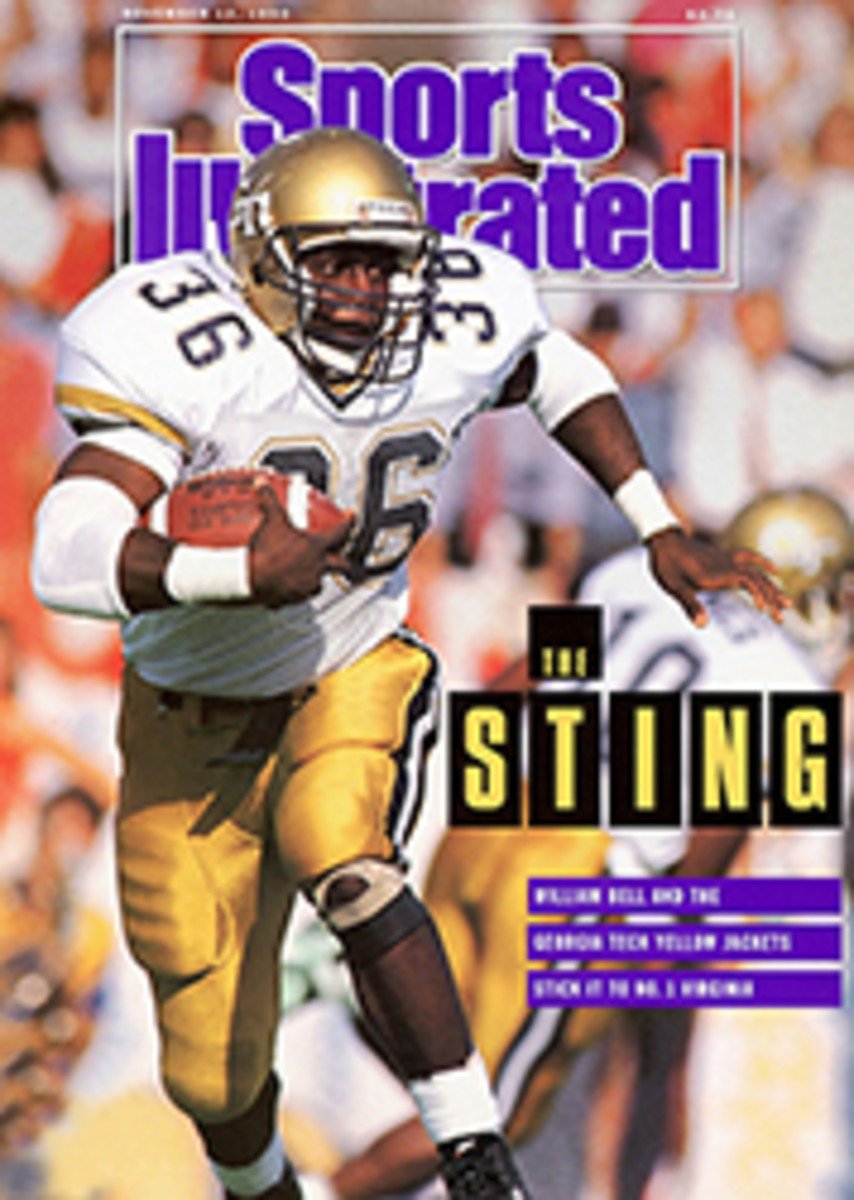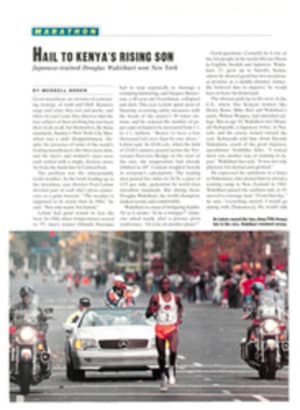
ONE OF THE BIGGER WHEELS
Last February, when The New York Sports Museum & Hall of Fame inducted 90 charter members, cyclist Alf Goullet was an obvious choice. In the early 1920s, Goullet was so popular with the crowds for the six-day races at Madison Square Garden that they set attendance records, and Goullet was paid appearance fees of $1,000 a day. At the time, a National Football League franchise could be bought for just a few hundred dollars.
One of Goullet's greatest admirers was Damon Runyon, a writer known for his stories of professional athletes and Broadway characters. Runyon knew a champion when he saw one and often wrote articles comparing Goullet to Babe Ruth. After Goullet's dramatic victory in the Garden's December 1921 six-day race, Runyon devoted an editorial in the New York American to the bicyclist, pronouncing him king of the six-day racers and proclaiming, "Long live the king!"
Prophetic words: Last April 5, Goullet celebrated his 99th birthday. He appears to be much younger than his age. In 1982 he appeared before a Newark City Council meeting to testify in favor of setting aside city property for a cycling track. Those who were called on before Goullet had stepped up to a microphone, but when Goullet's turn came he stood in the aisle and delivered his remarks unamplified in a clear, resonant voice.
"My name is Alf Goullet, and I came to Newark from my native Australia in 1910 to race bicycles professionally," he said. His argument for a velodrome was a highlight of the meeting, though the track has not yet been built.
When Goullet arrived in Newark at age 19, cycling was thriving. The local cycling arena, which could seat 12,500 for the twice-weekly programs, was often sold out; those turned away could go to Wiedenmayer Park to watch the Class A Newark Bears play baseball. Today, to most Americans, bicycle racing means Greg LeMond riding the roads of Europe in races such as the Tour de France. When Goullet first came to the U.S., an American racing circuit lasting almost the entire year produced such homegrown world champions as August Zimmerman, Major Taylor, Bobby Walthour Sr. and Frank Kramer. "Every really good cyclist wanted to come to America because the best riders came here to compete," says Goullet.
The races in which Goullet first made his name were often held outdoors on steeply banked board tracks, most measuring six laps to the mile. Race promoters usually charged an admission price of 25 cents and put on a variety of events: handicap races, matched sprints pitting two or three star riders over the course of a mile, and massed-start races with dozens of cyclists competing at distances up to 50 miles.
Goullet went wherever the sport took him, which in 1912 was Salt Lake City. There he set three world records, at distances of two thirds of a mile, three quarters of a mile and the mile. After that summer ended, he and a coterie of riders went to Europe to race on indoor tracks.
In January 1913, he competed in the inaugural Paris six-day race; to this day, that event continues to draw some of the best international talent. In Paris, Goullet teamed up with Joe Fogler of Brooklyn, and they were triumphant, beating such stars as Tour de France champions Octave Lapaize and Lucien Petit-Breton.
What grew to be the Super Bowl of international bicycling, though, was the six-day race held in Madison Square Garden, where, day after day, the event drew standing-room-only crowds.
In November 1914, Goullet teamed with Alfred Grenda of Tasmania for the Garden's six-day race, and set a world record for the event that still stands. An attack of appendicitis kept Grenda on the sidelines during the final hour of the grueling race, forcing Goullet to fend off the other teams alone. But Goullet battled back to win the final sprint. During the six days, the two bicycled 2,759.2 miles, the distance from San Francisco to Buffalo, and 638.2 miles farther than this year's Tour de France, which was won by LeMond in 21 days of racing.
Over the next several seasons, when Goullet wasn't racing, he continued to spend time in Newark. He became a U.S. citizen in 1916. When the U.S. went to war with Germany in 1917, Goullet enlisted in the Navy. He never left the country, however, and after the war had ended he was mustered out in time to train for the 1919 season.
By then American cycling was beginning its golden era. Sixes enjoyed a phenomenal following. The Garden included another six-day in its yearly program—the November race was moved to December and one in March was added. A six consisted of two-man teams, one of whose members had to be competing night and day while the other ate and slept. During each of the six days of the race, there were usually three sprint programs—one in the afternoon, one in the early evening and one late at night, after the theaters had let out—that offered additional money or prizes to the racers as well as extra points. Six-day fever, so contagious in New York and Boston, quickly spread to other cities, including Chicago, Toronto and San Francisco.
"Every six-day I ever was in was my last," Goullet says. "They were always so hard. Then after a rest of two or three days, I was all set for the next one. Forgetting the physical discomfort was a blessing."
Goullet was particularly impressive in the December 1921 six-day at the Garden. He was paired with Italy's Maurice Brocco against a top international field of 15 two-rider teams. On Saturday night, with the midnight finish five hours away, so many spectators filled the Garden that the city's fire marshal ordered a cordon of firemen around the building to prevent anyone from sneaking in.
The boisterous crowd of more than 15,000 was on its feet, cheering wildly. With the pressure on, teammates relieved one another with a mighty push to keep up the bicycle's speed. Several teams were in contention for the $50,000 purse—equal to some $375,000 today.
Goullet charged around the track to win 13 of 18 two-mile sprints in the last few hours. The New York Times reported, "Goullet won the race through the greatest exhibition of sustained speed ever known in history."
Goullet profited greatly from his ability to take two-hour naps and wake up refreshed. "Every time the bell rang to announce a sprint, I responded like a firehouse dalmatian," he recalls.
By 1925, Goullet had won about 400 races on three continents, set six world records and captured eight Garden six-days with six different partners. Then, at 34, he announced plans to retire after the Garden's December six-day and raise a family with his new wife, Jane. In recognition of his popularity, he was paid an appearance fee of $10,000.
Goullet retired in glory' and was selling life insurance when cycling went bust with the Depression. He attributes the downfall of American professional cycling to bad management. "Those in charge only took without putting anything back," Goullet says. He also lays some of the blame on the riders. "We were just looking out for ourselves. We didn't have the brains to get a headache."
During the Depression, the sport's center shifted from the U.S. to Europe, and from the track to the road. The outbreak of World War II ended the era that had drawn Goullet to the States. Like that of Zimmerman, Taylor, Walthour and Kramer, Goullet's fame began to fade.
"I adjusted," he says. "There were a lot of other things to do—with my life, my wife and family."
"He never pushed us into sports," says his son, Richard, a financial planner in Middletown, N.J. "I played tennis in high school, and Dad never missed seeing a tournament I was in."
Daughter Suzanne Klein, who lives in San Mateo, Calif., says her father would speak of cycling but didn't dwell on it. "He was never one to live in the past. He always focused on the future. Besides, growing up when we did, the sport was gone and there was no way to relate to it," she says.
But quality has a way of enduring. In 1968, Goullet was inducted into the Madison Square Garden Hall of Fame. Then, four years ago, he was flown to Melbourne—his first trip to Australia in 75 years—for induction into the Australian Sports Hall of Fame. When the U.S. Bicycling Hall of Fame was founded several years ago, in Somerville, N.J., Goullet was a first-round inductee, in May 1988.
Over the years, Goullet has survived the loss of many close friends and the death of his wife of more than 50 years. Five years ago, after a pair of neighborhood toughs tried to rob him on the sidewalk in front of his home in Newark, he moved to Red Bank, N.J., not far from his son. "My son doesn't like it when I drive alone in New Jersey," says Goullet, whose eyesight without glasses is still 20/30.
Last February when he was inducted into The New York Sports Museum & Hall of Fame, the electors recalled his career—as well as those of Runyon and 88 other local heroes, including Ruth and Jack Dempsey. Runyon, who died at 62 in 1946, would have been amused by the ceremony. Seventy years ago, when he called Goullet the king of the six-day bike racers, he exhorted the king to live long—and to live well. The king certainly has.
PHOTO
UPI/BETTMANN NEWSPHOTOS
In Garden races, Goullet would nap and awake refreshed.
PHOTO
MARK WEXLER
Goullet still has the bicycle that served him so well in his youth.
Peter Nye is the author of "Hearts of Lions: The History of American Bicycle Racing."

